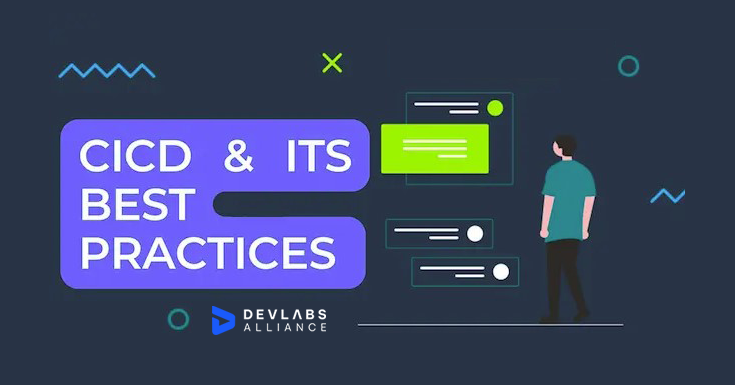

Similar Blogs
Popular DevOps Interview Questions – 2025
0 mins read
2023-09-07
Top 20 Jenkins Interview Questions and Answers - 2025
0 mins read
2024-03-22
What is supervised learning?
0 mins read
2023-09-07
What is Nagios?
0 mins read
2023-09-07
What is a Docker container? How do you create, start and stop containers?
0 mins read
2023-09-07
What is CI? What is its purpose?
0 mins read
2023-09-07
What does CI/CD stand for
The DevOps movement gave birth to software development approaches such as continuous integration, delivery, and deployment. They speed up the process of developing, testing, and distributing software by reducing the time it takes to get working software into the hands of users. A CI/CD pipeline allows teams to rapidly deploy working software when done correctly, while also receiving quick feedback on their most recent modifications.
Any successful DevOps methodology relies on continuous integration and delivery (CI/CD). CI/CD best practices must be followed by teams who aspire to accomplish modern software development.
It’s a technological process, a mindset, and a sequence of actions. CI/CD encompasses all of these aspects. Continuous Integration (CI) allows DevOps teams to automate code development. CI automates software builds and source code integration, while enabling version control and promoting more collaboration.
With automated testing and deployment, continuous delivery takes over where continuous integration leaves off. As a result, CD allows teams to substantially minimize the number of tools required to manage the lifecycle, but it also allows them to spend less “hands-on” time on delivery and deployment.
Best practices for CI/CD implementation
DevOps CI/CD best practices improve the efficiency and speed of building, testing, and releasing software. Because DevOps CI/CD services necessitate sending and receiving quick feedback on the most recent modifications, it pays to study your feedback data to improve your process.
1. The only option is to use a CI/CD pipeline
Nothing should jeopardize a fast, reliable, and secure CI/CD pipeline once it’s been constructed. Typically, a request for a shortcut is made when only small changes are required or when time is of the essence.
Both explanations may appear true, yet they are insufficient to dilute the procedure. Skipping any automated testing stages might result in avoidable difficulties, making recreating and troubleshooting issues much more difficult because the build is not readily available for deployment to a testing environment. To get stakeholders on board, it’s essential to highlight the CI/CD benefits.
2. Make early and frequent commitments
Before implementing continuous integration, you must first guarantee that your source code, configuration files, scripts, libraries, and executables are all in source control. Because contributors exchange tiny updates regularly, continuous integration makes integrating changes from various contributors simple. Each one starts a series of automated tests to provide you with immediate feedback on the change. As a result, committing frequently enhances teamwork and lowers merge conflicts when integrating more complex modifications.
It may be easier to embrace this technique if you work together to divide activities into smaller, defined parts.
3. Make it a collaborative effort
Building a successful CI/CD pipeline is as much about the culture of your team and company as it is about the processes and tools you employ. DevOps practices include continuous integration, delivery, and deployment.
They focus on breaking down conventional silos between developers, testers, and operations and encouraging cross-disciplinary collaboration.
4. Build only once
Each stage does not necessitate a new build. Rebuilding software for multiple conditions can cause inconsistencies, causing you to distrust the results of previous tests. Instead, the same build artifact should be promoted via each CI/CD pipeline stage. As a result, the design must be environment-agnostic. Rather than being incorporated into the build itself, variables, configuration files, authentication parameters, configuration files, or scripts must be invoked by the deployment script.
The same build can be deployed to each environment for testing. It boosts team members’ confidence in each artifact.
5. Monitoring and measuring pipeline
You’re probably already monitoring the production environment for early danger signals as part of setting up your CI/CD pipeline. As a result, a feedback loop will benefit your CI/CD workflow. You may look at the metrics collected by your CI/CD tool and see where you can improve. When you analyze the number of builds triggered per week, day, or hour, you can see how your pipeline infrastructure is used, whether it needs to be scaled up or down, and whether performance optimizations are needed. Statistics collected from automated tests aid in identifying locations where parallelization may be beneficial.
Test results should be reviewed regularly to assist in streamlining test coverage.
6. Keep your surroundings clean
It’s essentially taking the effort to clean up your pre-production settings between deployments if you want to get the most out of your testing process. It’s challenging to keep track of all the configuration changes and upgrades that have been performed to each environment when they’ve been running for a long time. In addition, environments diverge from the original setup over time; thus, tests that pass or fail in one may not return the same result in another.
Static environments have a maintenance cost, which can slow down testing and cause the release process to be delayed.
It’s simple to spin up and break down environments for each new test by using containers to host and perform tests.
7. Breaking down silos
Breaking down silos allows teams to understand the end-to-end process better and cooperate and benefit from different areas of knowledge. It should never be the responsibility of a single person to maintain the pipeline. Instead, you can encourage everyone on your team to contribute by fostering a sense of shared ownership for delivering your software – whether it’s jumping in to fix the build, spending the time to containerize environments, or anything else.
8. Infrastructure as Code (IaC)
Infrastructure as Code (IaC) refers to the management and provisioning of infrastructure using code rather than manual processes. IaC generates configuration files containing your infrastructure specifications, making it easier to edit and distribute configurations. It also ensures that you always provide the same environment. IaC facilitates configuration management and helps you avoid undocumented, ad-hoc configuration changes by codifying and documenting your configuration specifications. IaC is critical to implementing DevOps and continuous integration/delivery (CI/CD). IaC relieves developers of the majority of provisioning work by allowing them to run a script and have their infrastructure ready. Infrastructure code can go through the same CI/CD pipeline as an application during software development, with the same testing and version control.
9. Fail fast model
Nobody in management ever tells you that you’re going to fail.
It appears counterintuitive, given that failure is often disastrous to a business. However, when every other team is evaluating their effectiveness based on their successes, the last thing you want to do is encourage your team to fail.
Surprisingly, that is precisely what a DevOps culture requires, and the faster you fail, the quicker you achieve success.
Here is where a fail-fast culture comes into play. The goal of fail-fast in DevOps is not to maximize failure, but to encourage development teams to experiment in a structured environment where the faster they fail, the faster they can discover ways to improve systems and products. This “fail-fast” mechanism popularized in Agile environments can be migrated to DevOps environments if managers limit the costs of failure, particularly regarding the impact on customer services. In addition, this “fail-fast” mechanism popularized in Agile environments can be migrated to DevOps environments if managers limit failure costs, particularly regarding the impact on customer services.
Conclusion
DevOps is a method of working that involves people, technologies, and processes to meet, if not exceed, client expectations. Teams in the DevOps lifecycle focus on delivering value in a safe, rapid, and repeatable manner, helped by best practices in Continuous Integration and Continuous Delivery (CI/CD). This process aids enterprise cross-functional teams by automating, governing, and securing the whole software delivery process. By bringing automation, governance, longevity, and security to the software delivery process, Continuous Integration and Continuous Delivery (CI/CD) assists cross-functional teams with their tasks. Adopting best practices of any kind is to meet the enterprise’s goals as efficiently and effectively as possible.
INQUIRY
Want To Know More
By tapping continuing, you agree to our Privacy Policy and Terms & Conditions
“ The hands-on projects helped our team put theory into practice. Thanks to this training, we've achieved seamless collaboration, faster releases, and a more resilient infrastructure. ”

SkillAhead Solutions
Similar Blogs
Popular DevOps Interview Questions – 2025
0 mins read
2023-09-07
Top 20 Jenkins Interview Questions and Answers - 2025
0 mins read
2024-03-22
What is supervised learning?
0 mins read
2023-09-07
What is Nagios?
0 mins read
2023-09-07
What is a Docker container? How do you create, start and stop containers?
0 mins read
2023-09-07
What is CI? What is its purpose?
0 mins read
2023-09-07

USA
1603, Capitol Avenue, Suite 413A, 2659, Cheyenne, WY 82001, USA

`Copyright © DevLabs Alliance. All rights Reserved`
|
Refund & Reschedule Policy
Privacy Policy
Terms of Use


